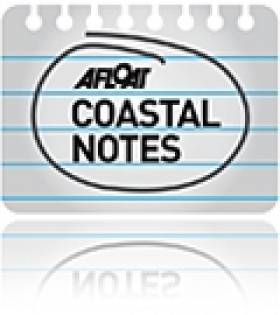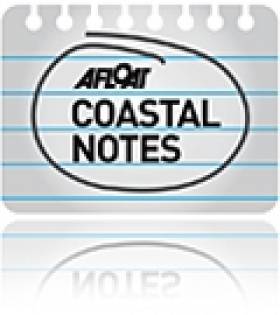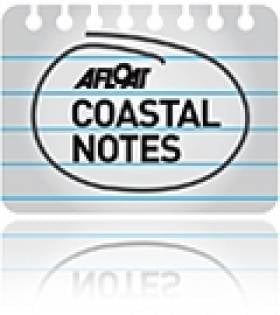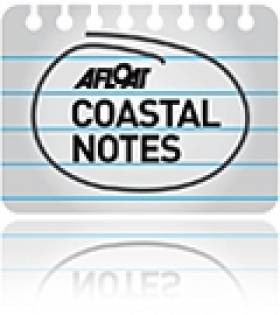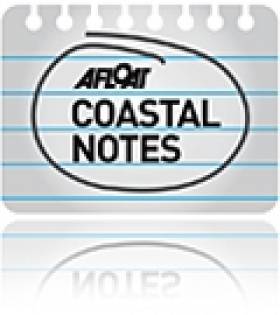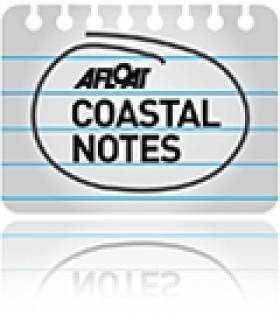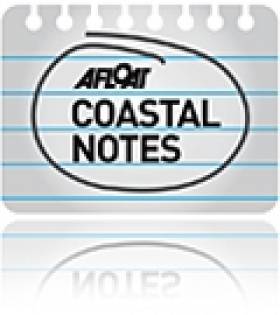Displaying items by tag: Coastal Notes
West Coast Extreme Storm Risk Up 25% Says New Study
#CoastalNotes - Climate change has increased the risk of extreme weather on Ireland's West Coast by 25% according to new research.
As RTÉ News reports, the mathematical models calculated by Oxford professor Myles Allen are the first to draw a direct link between human-induced affects on climate and weather patterns in this specific region.
And Prof Allen's "clear cut" conclusion is that an extreme storm system should now be expected every 80 years, as opposed to the previous estimates of every 100 years or so.
He suggests his findings should serve as a warning to people in vulnerable coastal communities, many of which were badly affected by last year's succession of winter storms.
The mathematician called on the power of many thousands of home computers, whose users volunteered in a project akin to the SETI@home project to find life in outer space.
RTÉ News has more on the story HERE.
Achill Islanders Not So 'Keem' On Viewing Platform Plans
#IslandNews - A glass-floored viewing platform jutting out over the Atlantic Ocean on Achill Island has got officials excited about its potential to attract tourism.
But locals are concerned that the project could mar the area's special views with an eyesore.
As the Mayo News reported last month, funding has been secured to develop the so-called 'Signature Discovery Point' at Keem Beach on Ireland's largest coastal island.
Keem Beach is one of 35 locations along the Wild Atlantic Way in Co Mayo that will share in the €257 million funding pot.
And the ambitious plans for the area – that also features as part of the new Galway-Mayo Blueway – include a viewing platform over the waves and rocky shore near the old coastguard station, along the lines of the Grand Canyon Skywalk.
But the reaction among the Achill community has been mixed, with support for the initiative by development company Comhlacht Forbartha Áitiúil Acla tempered by comments from local sculptor Ronan Halpin, who expressed concerns over the "visual intrusion" and "sustainability" of such a unique engineering project.
“Keem Bay is one the most beautiful and unspoilt places in our country. Its isolation and seclusion are a major part of its inherent charm," he added. "The proposal to build a glass walkway at the top of Moiteóg would seem to fly in the face of all this natural beauty and majesty."
The Mayo News has much more on the story HERE.
Coastal, Lake Spots Among Ireland's 'Most Picturesque Destinations'
#CoastalNotes - Coastal spots and waterways feature heavily in HeraldScotland's list of the most picturesque destinations to visit in Ireland.
Some of these will be well known to locals and tourists alike, such as the wonders of Antrim's coast and glens (not least the Giant's Causeway and the Carrick-a-Rede rope bridge), the majestic Ring of Kerry and the breathtaking Cliffs of Moher.
But some perhaps lesser-known spots getting their due here include the Cavan lake country – with one to explore by kayak for every day of the year – and the Cooley Peninsula in Co Louth.
HeraldScotland has much more on the story HERE.
Armada Wreckage Washed Onto Sligo Shore
#SpanishArmada - More wreckage from Spanish galleons shipwrecked off the northwest coast more than 400 years ago has been washed up on a Sligo beach.
And according to The Irish Times, it's possible that this weekend's low tides could expose even more remnants from the three vessels - sparking concerns for the integrity of the wreck sites, which lie in 15 metres of water some 60 metres from the low tide mark.
Donal Gilroy from the Grange and Armada Development Association (GADA) said the wooden objects found on the beach this week had "been buried off Streedagh for nearly 430 years. It is lucky they were not carried out by the tide.”
The find comes just months after a near fully intact rudder, believed to be from one of the 1588 fleet, was discovered at Streedagh beach by a local farmer.
“This is a protected site but we worry that these boats are being moved by storms," added Gilroy. "They have thrown up more in the last two years than in the previous 40."
The Irish Times has more on the story HERE.
Inchydoney Tops 'Best Beach' List For Second Year Running
#Beaches - And the title of Ireland's best beach goes to... Inchydoney in West Cork, as TheJournal.ie reports.
This marks the second year in a row that the Clonakilty strand took the top spot in TripAdvisor's annual ranking of Ireland's beaches, as chosen by visitors and tourists giving their ratings on the site.
It couldn't come at a better time for Inchydoney, as next month signals the start of the best period of the year to make the most of its peaceful atmosphere.
Elsewhere on the top ten list, Kerry places the most with four beaches making the grade - including Derrynane and Inch at numbers two and three respectively.
But the east coast also gets a look-in, with Curracloe in Wexford placing sixth, and Portmarnock in North Co Dublin rounding out the list at number 10.
TheJournal.ie has much more on the story HERE.
Bantry Bay Oil Terminal Sold to US Based Owners
#WhiddyOilTerminal – Bantry Bay Oil Terminal has been acquired by Houston, Texas based Zenith Energy, an international liquids and bulk terminal company from Phillips 66.
The terminal has a storage capacity of more than 8 million million barrels holding a third of Ireland's strategic petroleum reserves. Zenith intends to continue operating the terminal on a commercial basis.
For more the West Cork Times reports HERE.
Phillips 66 continues to operate Whitegate Oil Refinery in Cork Harbour, the only such facility in Ireland. As previously reported on Afloat.ie the refinery at Whitegate was withdrawn from sale last year following attempts to find a buyer failed.
Mike King of Phillips 66 was among the speakers of the major energy conference "Cork Harbour – Energising the Region" held in December.
To read his presentation and others click HERE on topics that discussed the opportunities and challenges in terms of energy, industry and tourism for the harbour.
RFA ‘Atlantic Patrol Tasking North’ Replenishment at Sea Tanker Offshore of Greystones
#UKNavalTanker - RFA Wave Knight (A389) a 31,500dwt tanker which supplies the Royal Navy was some 20 nautical miles offshore of Greystones Harbour during a mid-week northbound passage in the Irish Sea, writes Jehan Ashmore.
The 10,000nm range Royal Fleet Auxiliary (RFA) vessel with a crew of 72, is the leadship of the 'Wave Knight' class of Fast Fleet Tankers that had departed Plymouth.
The vessel has not called to any Irish Port but is currently deployed on operation 'Atlantic Patrol Tasking North'.
She is also used to serve global operations, where the RFA Wave Knight provides fuel, food, fresh water, ammunition and other supplies in addition to support amphibious forces, anti-surface and anti-submarine warfare operations.
To carry out refuelling, RAS (Replenishment at sea) this is carried out through a hose-pipe rig, to a vessel either to port or starboard and also can be conducted astern.
Another role of the 196m vessel is to carry out helicopter missions on humanitarian relief events and also weapons systems operations. This requires 26 Royal Navy personnel for helicopter operations, noting the stern-landing deck and hanger as pictured HERE of the vessel.
Launched in 2000 at VSEL, Barrow-On-Furness, the Cumbrian port on the Irish Sea switched ownership during Wave Knight's fit-out. So by the time the 16,900 tonnes fuel capacity tanker was accepted into RFA service in 2003 this was then during control of BAE Systems Marine.
She is the second ship to bear this name in RFA service and her sister RFA Wave Ruler (A390) was also named after a previous oiler replenishment tanker. As previously reported, RFA Gold Rover (A271) another RAS tanker made a visit to Dublin Port last year.
Also reported was this week's visit of the French Navy's BCR Somme (A 631) to Dublin Port. The auxiliary oil replenishment tanker (AOR) again another term for this type of naval support vessel is seen carrying out a RAS operation as captured by clicking this VIDEO link.
It was during the four-day visit that the French Ambassador to Ireland presented the Legion d'Honneur to Michael 'Mickey' d'Alton's contribution to the success of D-Day in 1944.
For much more about one of the last Irish survivors of this critical event during WW2, Afloat's W. M. Nixon reflects on some very special stories of this senior Dun Laoghaire sailor.
Following the ceremony, the Somme departed Dublin Port last Tuesday morning.
The Brest-based ship which is home-ported in the Breton naval base to carry out her area of operations in the Atlantic, was instead understood to be bound for another base in Toulon on the Mediterranean.
Shipwrecks, Murder, Jedi Knights: Ireland's Islands Have Stories To Go With The Views
#Coastal - Ireland's coastal islands offer some astounding vistas, as this breathtaking video from the Smithsonian Channel shows perfectly.
The clip from the American TV channel's Sky View series sweeps high above the Aran Islands to highlight the rugged beauty of the west coast, from the skeletal shipwrecks to the rocky shores to the veins of stone walls across the green landscape.
It's easy to see why the Wild Atlantic Way is such a draw for tourists, but let's not ignore the bounty of the east coast either, as the Irish Independent highlights the New York Times' celebration of Dublin Bay's world-class views for "little more than the cost of a pint".
Cited as "one of the most beautiful views in the world" in that tribute is the vista as seen from Howth Head, from where one has a perfect 'eye-catching' view of the enthralling Ireland's Eye.
The tiny island, with its prominent Martello tower, is less than a mile from the North Dublin fishing village, and doesn't even seem that far from the end of the pier.
But as Conor Pope reports in The Irish Times, it "may as well be on a different planet", describing a place full of mystery, history – and even murder.
Meanwhile, off the southwest coast there's another tiny rock with its own storied past that's about to take on a whole new relevance to fans of the Star Wars saga.
BBC News reports on Skellig Michael, the island "that links Irish monks and Jedi knights" after filming took place last year for the hotly anticipated movie The Force Unleashed.
The island is already a popular spot for visitors, but could soon welcome many more – with lightsabers in tow!
West Cork Weather Buoy Records Second Highest Wave
#WaveRecord - The M3 weather buoy has measured the second highest wave ever recorded off the West Cork coast, according to The Skipper.
The buoy measured an individual wave of 16.9 metres at 10am last Thursday 15 January in the midst of Storm Rachel, a little over two metres shy of the 19.1m wave recorded on 27 January 2013.
The Coast of West CorkThe stormy conditions have seen consistent but unusually high seas this month so far, with the M3 buoy - which was swept away to Devon in storms two years ago – recording an average Significant Wave Height of over six metres.
Meanwhile, in the Irish Sea the M2 buoy recorded an individual wave of 8.7m at 10pm on 14 January, just 18cm below the record set on 27 December 2013.
Coastal, Seabed Maps & Guides Go Irish
#CoastalNotes - Irish school pupils will benefit from the publication of new maps and guides to the country's onshore and offshore geology in the Irish language.
Derek Evans writes in The Irish Times on the recent launch of An Geolaíocht ó bhun go barr at Letterkenny's Coláiste Ailigh, in conjunction with translated editions of the Bedrock Geological Map of Ireland and the Real Map of Ireland - the latter of which is an important resource for studying the seabed around the Irish coast.
Published by the Sherkin Island Marine Station, An Geolaíocht ó bhun go barr is an accessible study guide to the basic geological and geographical processes relevant to Ireland, and is particularly useful for post-primary schools both within Gaeltacht areas and nationwide.
But it also has value to adults who can learn about the natural history of Ireland and improve their Irish at the same time.
The launch is part of commitments made under the Department of Gaeltacht Affairs’ Irish Language Scheme to translate and publish a wide range of literature from the Geological Survey of Ireland.




























